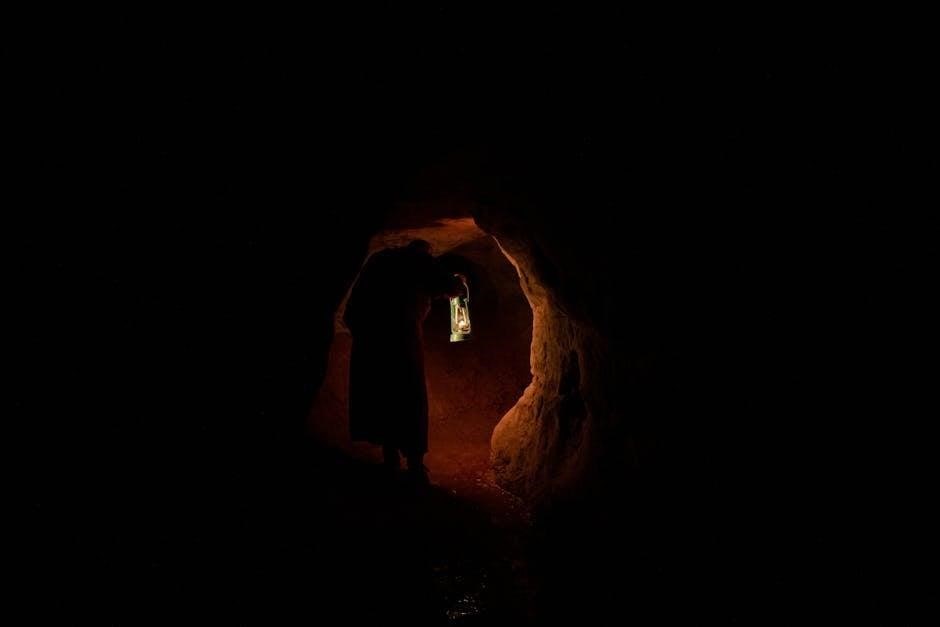The Ultimate Hitchhiker’s Guide to the Galaxy: An Overview
The Hitchhiker’s Guide to the Galaxy, created by Douglas Adams, began as a 1978 radio series, evolving into a beloved book, TV show, and film. This comedy science fiction saga follows Arthur Dent’s misadventures through space, exploring themes of humanity, technology, and existence with humor and wit.

The Hitchhiker’s Guide to the Galaxy, conceived by the brilliant comedic mind of Douglas Adams, first emerged as a groundbreaking 12-part radio series on BBC in 1978. What began as a quirky, surreal tale of intergalactic misadventures quickly blossomed into a multimedia phenomenon, captivating audiences worldwide. The franchise expanded into novels, television series, films, stage plays, and even video games, solidifying its place as a cult classic. At its core, the story follows the hapless Arthur Dent, an ordinary Earthman thrust into the vastness of space after Earth’s demolition to make way for a hyperspace bypass. Joined by an alien researcher named Ford Prefect and armed with the titular guidebook, Arthur navigates a universe filled with absurdity, satire, and existential questions. Adams’ unique blend of humor, science fiction, and philosophy resonated deeply, turning the franchise into a cultural icon. Its legacy endures, inspiring new adaptations and maintaining a loyal fan base across generations.

The Original Radio Series and Its Impact
The original radio series of The Hitchhiker’s Guide to the Galaxy, broadcast on BBC from 1978 to 1980, marked the beginning of a cultural phenomenon. Conceived by Douglas Adams, the series brought a fresh wave of surreal humor and science fiction to the airwaves, captivating listeners with its unique storytelling and imaginative world-building. The show’s 12 episodes introduced audiences to iconic characters like Arthur Dent, Ford Prefect, and Marvin the Paranoid Android, setting the foundation for the franchise’s success. Its impact was immediate, as it not only garnered a devoted fan base but also influenced the broader landscape of comedy and science fiction. The radio series laid the groundwork for subsequent adaptations, including novels, television shows, and films, cementing its legacy as a groundbreaking work in entertainment. The series’ innovative approach to blending humor with deep philosophical questions continues to inspire creators and entertain audiences alike, ensuring its place as a timeless classic.

The Five-Book Series and Its Popularity
The Hitchhiker’s Guide to the Galaxy evolved into a five-book series, despite Douglas Adams initially calling it a trilogy. The books—The Hitchhiker’s Guide to the Galaxy (1979), The Restaurant at the End of the Universe (1980), Life, the Universe and Everything (1982), So Long, and Thanks for All the Fish (1984), and Mostly Harmless (1992)—captivated readers worldwide with their unique blend of humor, science fiction, and philosophical musings. Adams’ witty prose and absurd storytelling resonated with audiences, making the series a global phenomenon. The books explore themes of technology, humanity, and the search for meaning in an often illogical universe. Their popularity led to translations into numerous languages and adaptations into TV series, films, and even video games. After Adams’ death, Eoin Colfer added a sixth book, And Another Thing (2009), continuing the legacy. The series remains beloved for its originality and humor, offering readers a timeless journey through space and ideas. Its enduring appeal lies in its ability to entertain while provoking thought about life’s biggest questions.

Key Elements of the Guide
The guide features iconic elements like the Heart of Gold, Deep Thought, Magrathea, and the Vogons, blending humor and science fiction to explore life’s mysteries through Arthur Dent’s journey across the galaxy.
The Protagonist: Arthur Dent and His Journey
Arthur Dent, the quintessential Englishman, finds his mundane life shattered when Earth is demolished to make way for a hyperspace bypass. Rescued by his friend Ford Prefect, an alien researcher for the Hitchhiker’s Guide, Arthur embarks on a surreal journey through the galaxy. Clinging to the guidebook and a Babel fish for translation, he navigates the absurdities of space, encountering eccentric beings like Zaphod Beeblebrox, the two-headed president, and Marvin, the perpetually depressed robot. His travels aboard the Heart of Gold, powered by the Infinite Improbability Drive, lead him to Magrathea, where Earth’s true purpose as a supercomputer is revealed. Arthur’s journey is both a quest for survival and a search for meaning, as he grapples with the universe’s randomness and the enigmatic answer to life, the universe, and everything—42. Through his adventures, Arthur evolves from a hapless bystander to a resilient wanderer, embodying the spirit of adaptability and humor in the face of cosmic chaos.

Ford Prefect: The Alien Researcher and His Role
Ford Prefect, an alien researcher from a planet near Betelgeuse, plays a pivotal role in Arthur Dent’s journey. Working on the Hitchhiker’s Guide to the Galaxy, Ford rescues Arthur moments before Earth’s destruction, introducing him to the absurdities of the cosmos. With his calm demeanor and resourcefulness, Ford serves as Arthur’s guide, providing essential tools like the Babel fish for universal translation and the guidebook itself. His knowledge of alien cultures and advanced technology helps the duo navigate encounters with Vogons, Marvin, and other eccentric beings. Ford’s character represents the bridge between humanity and the vast, unpredictable galaxy, offering both humor and insight. His friendship with Arthur underscores themes of loyalty and adaptability, making him a central figure in the narrative. Ford’s contributions to the guidebook also highlight the importance of exploration and understanding in an infinite universe. His role extends beyond mere research, as he becomes a catalyst for Arthur’s growth and the group’s survival, embodying the spirit of adventure and curiosity that defines the Hitchhiker’s Guide series.
The Heart of Gold and the Infinite Improbability Drive
The Heart of Gold, a stolen spaceship, is central to the Hitchhiker’s Guide saga, equipped with the revolutionary Infinite Improbability Drive. This groundbreaking technology enables faster-than-light travel by manipulating probability, allowing the ship to traverse vast distances instantaneously. The drive’s operation relies on a fundamental misunderstanding of physics, making it a marvel of alien engineering. Its activation often results in surreal and unpredictable side effects, such as temporarily transforming passengers into other beings, adding to the story’s humor and chaos. The Heart of Gold’s theft by Zaphod Beeblebrox, the two-headed president of the galaxy, sets the stage for Arthur Dent and Ford Prefect’s adventures. The ship’s computer, Eddie, further enhances its capabilities with a cheerful yet annoying personality. The Infinite Improbability Drive becomes a key plot device, enabling the crew to evade danger and explore the galaxy’s most bizarre corners. Its inclusion in the story highlights Douglas Adams’ imaginative approach to science fiction, blending absurdity with scientific concepts to create a unique narrative experience.

The Supercomputer Deep Thought and the Answer to Life
The Supercomputer Deep Thought, a creation of hyperintelligent pan-dimensional beings, was designed to calculate the “Answer to the Ultimate Question of Life, the Universe, and Everything.” After 7.5 million years of computation, Deep Thought revealed the answer as 42, but the precise question remained unknown. This conundrum led to the construction of Earth as a second supercomputer to find the question. Earth’s destruction by Vogons to make way for a hyperspatial bypass occurred just as it was nearing the solution. Deep Thought’s legacy plays a central role in the narrative, driving characters like Zaphod Beeblebrox, Trillian, and Arthur Dent to seek answers. The quest for meaning, underscored by Deep Thought’s enigmatic answer, reflects the series’ exploration of existential themes. Slartibartfast, a Magrathean designer, and the hyperintelligent mice further illuminate the mystery, adding layers of absurdity and depth to the story. The search for the ultimate question becomes a metaphor for humanity’s eternal pursuit of purpose in an often incomprehensible universe.
The Restaurant at the End of the Universe

The Restaurant at the End of the Universe, a luxurious and surreal dining establishment, is situated at the cosmos’ edge, where patrons can watch the entirety of existence unfold. Accessible via time travel, this eatery allows guests to see the birth and death of stars while savoring exotic cuisine. The restaurant’s menu features dishes like “Ravenous Bugblatter Beast of Traal” and drinks such as “Pan-Galactic Gargle Blasters.” A unique feature is its use of temporal displacement fields, enabling diners to witness events from any point in the universe’s history. The restaurant is a hub for diverse alien species and eccentric characters, adding to its chaotic charm. Arthur Dent and his companions visit this locale, encountering bizarre creatures and experiencing the absurdity of cosmic existence. The restaurant symbolizes the series’ blend of humor and philosophical musings, offering a glimpse into the infinite possibilities and unpredictability of the universe. Its eccentric staff and clientele further enhance the narrative’s comedic and satirical elements, making it a memorable setting in the Hitchhiker’s Guide saga.
Magrathea: The Legendary Planet Builders
Magrathea, a planet shrouded in mystery, is renowned for its inhabitants’ extraordinary skill in constructing custom-made planets. This legendary world, hidden from the rest of the universe, was once a thriving hub of intergalactic engineering. The Magratheans, its enigmatic inhabitants, built planets for wealthy clients, including Earth, which was designed as a massive supercomputer to find the “Answer to Life, the Universe, and Everything.” After completing Earth, the Magratheans seemingly vanished, leaving behind only remnants of their civilization. When Arthur Dent and his companions visit Magrathea, they discover that the planet’s inhabitants are not extinct but have been in a state of economic-induced hibernation. The Magratheans return to their craft, constructing a second Earth, further entangling Arthur in the quest to uncover the ultimate question to match the answer “42.” Magrathea’s legacy as a planet builder underscores the blend of humor and existential inquiry that defines The Hitchhiker’s Guide to the Galaxy.

The Vogons and Their Role in the Story
The Vogons are a race of unpleasant, slimy, and bureaucratic aliens central to the plot of The Hitchhiker’s Guide to the Galaxy. Known for their disdainful attitude and love of poetry, they serve as the primary antagonists in the early stages of the story. The Vogons are responsible for the destruction of Earth to make way for a hyperspace bypass, an event that sets Arthur Dent’s journey into motion. Their brutal methods and lack of empathy highlight the absurdity of bureaucratic systems in the universe. Ford Prefect, Arthur’s alien friend, reveals that the Vogons are not just destroyers but also contributors to the Hitchhiker’s Guide to the Galaxy, underscoring their dual role as both antagonists and integral parts of the galactic society. The Vogons’ actions drive the narrative forward, leading Arthur and his companions into a series of surreal and dangerous adventures. Their presence serves as a comedic critique of red tape and the often illogical nature of authority, making them memorable and pivotal characters in the story.




